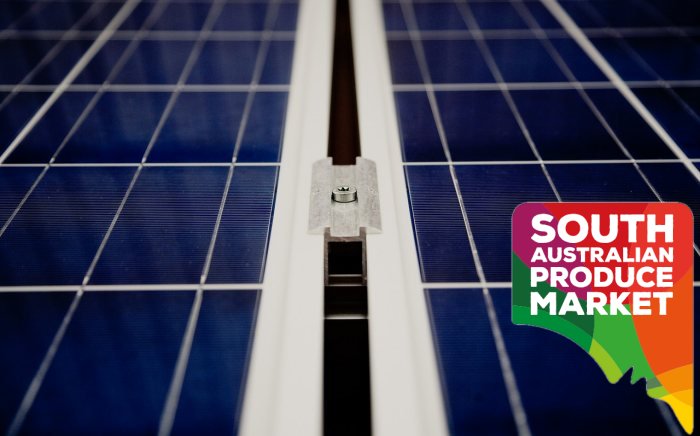
Solar panel image: marcusspiske
In yet another big renewables announcement for SA, the South Australian Produce Market in Adelaide’s northern suburbs will soon be home to a microgrid featuring solar and battery storage.
Established in 1988, the South Australian Produce Market is located in the suburb of Pooraka. More than 250,000 tonnes and $550 million of fresh produce is traded between dozens of growers and wholesalers and hundreds of retail operators at the market each year. The market also provides a significant number of jobs for residents of Pooraka and surrounding areas.
According to an announcement from the South Australian government, the microgrid will consist of a 4.2MWh lithium-ion battery, 2.5MW solar PV array (1,600 solar panels) and 2.5MW onsite generator; all controlled by a system being developed by local company AZZO.
The $10.5 million project has been made possible with a $2.5 million State Government Energy Productivity Program grant. The Program assists large energy-consumers in managing their electricity costs and in contributing energy supply benefits to the state.
“South Australia is at the forefront of advances in the deployment of this technology and projects like this one at the SA Produce Market demonstrate how much can be saved by investing in solar and batteries,” said Energy Minister Tom Koutsantonis. “Jobs are Labor’s number one priority and this microgrid will support jobs in our food industry by lowering the bills of stallholders at the market.”
The Government estimates stallholders at the market will save up to $5.5 million over the next decade compared to current SA retail electricity offers.
Energy has become a more pressing issue for the market, particularly with the upcoming Food Precinct Expansion, which will provide food processors with an opportunity to process on site, and to wholesale, retail and distribute products locally, interstate and overseas.
“We want to ensure we can continue to provide affordable fresh produce on a local and global platform and this initiative means we can do it with an environmentally friendly and cost-effective manner using an innovative solution,” said SA Produce Market CEO Angelo Demasi.
It’s been an SA-centric day here on SQ. Earlier today we reported on an exciting initiative that will see 50,000 solar + Tesla Powerwall 2 battery systems installed on homes across the state to form what’s claimed to be the world’s largest virtual power plant. We also published a story on the results of a recent poll on South Australian attitudes to renewables and storage.
There may be more SA announcements to come very soon – Minister Koutsantonis stated the Virtual Power Plant and markets system news kicks off a week in which the State Government will release details on more new renewable energy projects.

 RSS - Posts
RSS - Posts



This announcement is pure spin, rubbish and B.$hit
For instance, why are they putting in a generator if the system is meant to supply the grid?
The obvious answer is to “allow continued operation if the grid goes down”. A more cynical answer is to “top up the battery in cloudy weather” and remain independent of the grid.
So, if you have a big kick arse system with a big kick arse battery for an enterprise that operates mainly in daylight hours and you have a generator (all subsidised by the SA taxpayer to the tune of 24 odd %) why would you bother to remain connected to the grid and pay daily meter charges?
The stupid government of SA has shot itself in the foot here in their haste to make vote winning announcements using taxpayers money by helping to put in a PV system that is capable of going off grid, which rather defeats the purpose, doesn’t it?
Also, the stallholders don’t pay for electricity directly to the provider, the owner of the market does.
They (stallholders) pay via their stall fees which you can bet your bottom $, will not be going down any time soon.
The savings will go to the market owners bottom line.
I think the diesel generator will be there to operate as a peak power plant. This will add independently owned peak generation capacity to the grid. So for their $2.5 million grant, the state government is getting 2.5 megawatts of peak diesel generation, presumably 3+ megawatts of battery power output depending on its characteristics, and 2.5 megawatts of solar panels which will provide at least some power late in the afternoon during heatwaves which is when the grid is under the most stress. Looking at it that way, it doesn’t seem so bad.
In addition, if a cost of $70 a tonne is put on carbon emissions, at the moment 2.5 megawatts of solar panels will provide us all with about quarter of a million dollars a year worth of greenhouse gas emission reductions.